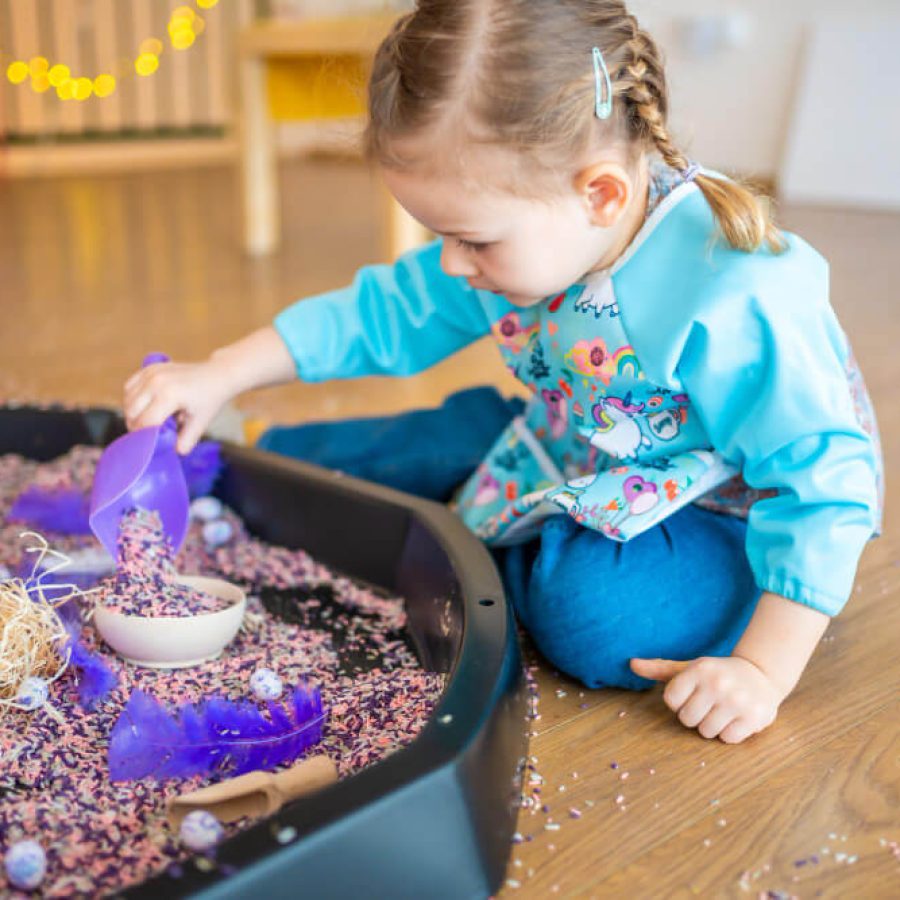If you’re looking for fun, hands-on, and educational ways to help your toddler learn at home, you’re not alone. A sensory bin is a container filled with materials that stimulate a child’s senses, mainly touch, sight, and sound.
It’s a budget-friendly way to engage your child in meaningful play.
One of the simplest options is a rice sensory bin. It’s a playful and calming activity that supports fine motor skills, creativity, and sensory development, all while keeping little hands busy. Best of all, you can easily make one at home.
Keep reading to check out our rice sensory bin ideas!
How to Create a Simple Rice Sensory Bin
Ready to get started? Here’s what you’ll need to make your own rice sensory bin at home and promote development in multiple important ways.
Materials:
- A shallow plastic container or storage bin with a lid.
- Dry rice (plain or dyed using food coloring and vinegar).
- Scoops, cups, measuring spoons, or funnels.
- Small toys, figurines, or themed objects based on your child’s interests.
How to do it:
- Place the container on a flat surface that is easy to clean.
- Pour dry rice into the bin until the bottom is well covered.
- Add scoops, cups, or spoons for pouring and scooping.
- Include small toys or objects that match your toddler’s interests.
- Invite your child to explore the bin with their hands and tools.
- Always supervise your toddler during play to ensure safety.
Creative Rice Sensory Bin Ideas
Once you have your basic rice bin set up, you’re in for a fun time with your Little One!
Try using creative themes to keep playtime fresh and exciting for your toddler.
- Rainbow Rice Bin: dye rice in bright colors and layer it in the bin. Add scoops, spoons, and clear cups for color-mixing fun.
- Nature-Themed Bin: fill the bin with rice, small twigs, leaves, pinecones, and plastic animals or bugs for outdoor-themed exploration.
- Alphabet Rice Bin: hide plastic or wooden letters in the rice. Ask your toddler to find and name each one, which is great for early literacy.
- Holiday-Themed Bins: change the bin with the seasons: mini pumpkins and orange rice for fall, red rice and hearts for Valentine’s Day, or green rice for St. Patrick’s Day.
If you don’t have rice or want more sensory bin options, you can try dried pasta, dried beans, pom-poms, kinetic sand, or even water beads.
Just ensure that the playtime is supervised to avoid the risk of ingesting the small objects.
Many household items can be transformed into sensory fun with just a little creativity, keeping the fun going by repeating the activity a little differently.
Simple Play, Big Benefits
Sensory bins are a simple, affordable way to create hands-on learning at home. They offer toddlers a chance to explore textures, colors, and objects in a safe, playful environment.
And you don’t need fancy toys — just curiosity, a bin, and a little imagination. Give it a try today, and watch your toddler discover joy in the simplest things!
Remember, sensory play doesn’t require expensive materials or elaborate setups. It’s all about offering your child hands-on experiences that spark curiosity and learning! With just a few household items, you can create moments that support growth and development.
Want to learn more? Check out our article about sensory play and its benefits for children!


